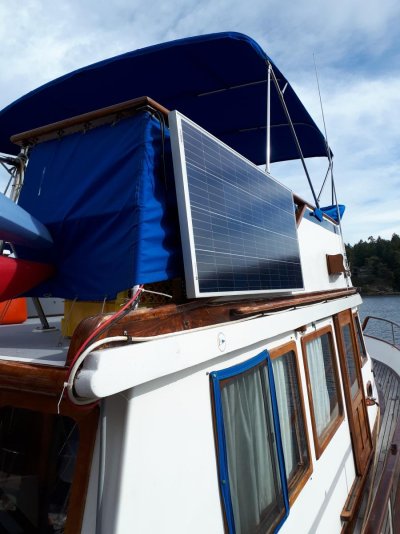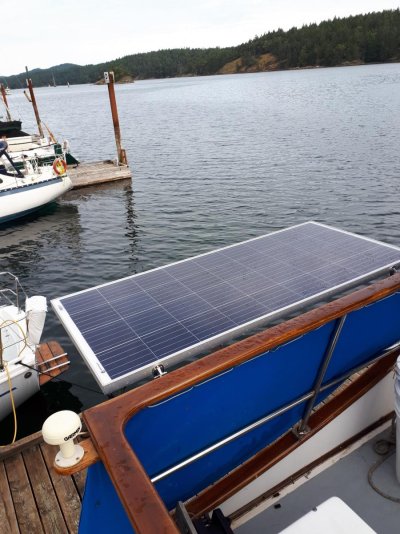Taking me a while to decode the above...
1. engines, so you have twins
2. you have a 24v system. Engines are forcing this with 24v starters ?
3. when I see (220V ac), I think of a euro boat, like mine, wired for 220 50Hz, with no 120v. But, I think you mean 240/120 50A shore power? Your 6kW genset is 240/120V?
4. alternators need to be changed again? what are they?
back to ER vents (i'm stubborn that way). You have fans, got it. Are they drawing from the top or bottom? I would draw the hottest air from the top.
Additionally, you could have make up air enter battery boxes directly, thereby exposing them to very close to OAT.
Diver Dave,
I indeed have twin Ford Lehmans, but they are 12 V, with each engine having its own battery pack.
At the moment all the batteries are still 12 V, so the 24 V and 220 V is created via inverters. The genset delivers both 12 and 220 V/50 Hz and via a switching board I can chose to power in the boat via shore power, genset power or via batteries. But this is a manual switching board, not automatic and not digital, plus there is no auto-start of the genset when the house batteries are empty.
There are also 4 solar panels of 150 Wp each, installed on the safety railing on the sun deck, they are connected via a inverter / charger to the batteries.
The boat is lying in Greece, so shore power is also 220 V / 50 Hz. There are no 120 V systems on board.
Alternators are, at the moment 12 V, but if I change to lithium batteries they will need to be changed as well. And if I switch to 24 V it would make sense to change them as well to 24 V.
Whether the ER vents draw from the top or bottom I would need to check. They were installed by an owner well before me, they function, but in the heat of the summer with OAT of well over 40 C they are having trouble keeping the ER cool.
The boat has a lot of heavy drawing equipment on board. Water maker, washing machine, dish washer, 3 fridges/freezers (1 x 12 V and 2 x 220 V), stove, microwave, water heater, 3 x air conditioning (inverter airco 1200 W each), windlass, dinghy lift, passerelle, dive compressor, plus all the electronics for navigation, laptops, printer, tv, trac vision, surround system etc.
What basically happened is that the former owners just kept adding and adding and adding, which is very nice, since the boat is more than luxurious, but the end result was that you basically have to run the generator 24 hours per day when you are on anchor.
In itself that is not too much of a problem, but I find it a pity to lie in a beautiful quiet bay................only to hear the humming of the generator all the time and, when the wind is wrong, smell the exhaust fumes.
Since there is an abundance of sun in Greece and Croatia (hardly any clouds during the summer time) it would be a pity not to use the sun as source of energy while on anchor.
Now that the house batteries are finished I see this as a good opportunity to overhaul the whole electrical system on board, reorganize, change and get more solar on board. The end result should be that I can run most of the time on solar and only a couple of hours per day on the genset.
That would create peace and quiet time while on anchor plus would greatly extend my range, since at this moment the genset is using about 0.5 to 1 liter per hour, but at almost 24 hours, 30 days per month for 5 months we are talking a very nice amount of fuel. Fuel in Europe is very expensive, but luckily I can get tax free fuel in Albania, which is about 60 % cheaper than in Greece and Croatia. However I do need to take into consideration that I need to be able to make it back to Albania for fueling (difference is about 4200 euro for a full tank). In other words, if I can reduce the use of the generator it will offer me huge fuel savings while at the same time increase my range and create peace and quiet time while on anchor. The fuel savings will basically recoup the cost of the conversion in 4 to 5 years. I call that a win-win-win situation.
So that is the thought process behind it all. The electrician came up with the idea to change to 24 V and lithiums. I came up with the idea to increase solar to 3000 Wp (minimum), so now need to figure out what is possible (stability wise), space wise (where to put everything) and cost wise.
Had some great inputs from everybody here so far, makes me think about AGM's again, but the stability has become an issue.



